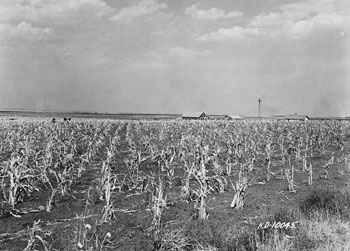
Dried up corn stalks caused by drought SHSND# 0351-06The summer of 1929 was very hot and dry with the temperature reaching as high as 110 degrees. Ann and Bud carried water to the garden every day in buckets to keep the vegetables and flowers alive. On August 19, frost damaged tomatoes, corn, beans, and cucumbers. However, Mrs. Riebe harvested enough from this damaged garden to feed the threshers a big meal that included “vegetables from her garden” along with pickles and potatoes and jelly from wild fruit. (Low, pp. 20, 28)
Potato bugs and grasshoppers attacked the Riebe farm in 1932. The grasshoppers confined most of their damage to the fields, but the potato bugs threatened a major winter food staple. Mr. Riebe knocked potato bugs off the plants into a pail. When he had all the beetles he would pour kerosene on the “little jewels” to kill them. (p. 67)
The summer of 1933 was very hot from the middle of June on. But Ann managed to get enough vegetables from the garden to do some canning in August. However, 1934 was the year when the preceding years of heat and drought began to deprive the farm garden of its previously abundant subsoil moisture. Ann and Bud planted potatoes in a dust storm in May. She wrote in her diary, “There was so much dirt in the air I couldn’t see Bud only a few feet in front of me.” The cistern dried up, so Ann and Bud had to carry water to the garden from the well. In spite of her efforts, the garden didn’t sprout. They re-planted the garden (and some of the field crops) in late June. They counted on the well which she described as the best around to provide adequate water for the garden, but in June she had some doubts about the well holding up to the demand. (p. 96)




